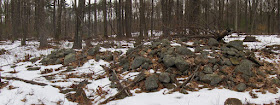"Similarly, more than 200 miles to the south, at the Oley Hills site, is Platform B (Fig. 15), a large stone platform with a terrace-like extension at the north end that ended at some large boulders, from above looking like the curved tail of a scorpion (Fig. 16). The similar morphology among these three examples is more than a coincidence, I believe, and reflects a widespread cultural and architectural response to the landscape. " (Take a look at Figures 4, 12, 14, and 15 from his report.)
So that is the background; I came to the same conclusion about a particular culture. Let's collect together some of the pictures. Here is Norman's Fig.14 (from VT)
 And his Fig 15 (from PA, showing the tail with the main pile to the left of the picture)
And his Fig 15 (from PA, showing the tail with the main pile to the left of the picture) And two examples I saw the other weekend (from Carlisle)
And two examples I saw the other weekend (from Carlisle)
 And I must add also the picture of the main pile at Apron Hill, Boylston MA
And I must add also the picture of the main pile at Apron Hill, Boylston MA Now, for better or worse, I took Apron Hill as the defining "archtypical" example of the Wachusett Tradition. So I am obliged to see these other sites with the same peculiar rock pile type as other examples of that Tradition and re-use the name. [It is just a word but it is in my head now; serving to organize other thoughts - a point of reference.]
Now, for better or worse, I took Apron Hill as the defining "archtypical" example of the Wachusett Tradition. So I am obliged to see these other sites with the same peculiar rock pile type as other examples of that Tradition and re-use the name. [It is just a word but it is in my head now; serving to organize other thoughts - a point of reference.]A couple of questions:
- what is the tail for?
- are all tails alike (some have more of a knob on the end)?
- what is the distribution of piles with tails?
- why do the tails curl clockwise only [so far anyway]?
- what is the cause or purpose of the hollow so often seen at the opposite end of the pile from the tail?
About: what is the tail for? I read Norman describe a "flat rock" at the end of one tail and also a tail that connects the pile to a spring.
ReplyDeleteI want to add that in the 2nd example shown from Carlisle, the terminal rocks on the tail look burned - like it was in a fire.
I don't recall ever seeing a rock pile with a tail in Rhode Island.
ReplyDeleteThere is a hole in the top of the cairn with the quartz cobble in Stockbidge, VT, but unfortunately, I don't have a photo of it. I've seen it, however.
ReplyDeleteI want to ask Larry: what about large rectangular piles with a hollow on top?
ReplyDeleteHaven't seen any large rectangular piles with a hollow on top in RI.
ReplyDeleteSmall round or oval cairns with a hollow on top are common.
Here's a couple of examples.
http://larryharrop.com/333.JPG
http://larryharrop.com/319.JPG